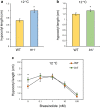TRANSTHYRETIN-LIKE and BYPASS1-LIKE co-regulate growth and cold tolerance in Arabidopsis
- PMID: 32664862
- PMCID: PMC7362626
- DOI: 10.1186/s12870-020-02534-w
TRANSTHYRETIN-LIKE and BYPASS1-LIKE co-regulate growth and cold tolerance in Arabidopsis
Abstract
Background: Cold stress inhibits normal physiological metabolism in plants, thereby seriously affecting plant development. Meanwhile, plants also actively adjust their metabolism and development to adapt to changing environments. Several cold tolerance regulators have been found to participate in the regulation of plant development. Previously, we reported that BYPASS1-LIKE (B1L), a DUF793 family protein, participates in the regulation of cold tolerance, at least partly through stabilizing C-REPEAT BINDING FACTORS (CBFs). In this study, we found that B1L interacts with TRANSTHYRETIN-LIKE (TTL) protein, which is involved in brassinosteroid (BR)-mediated plant growth and catalyses the synthesis of S-allantoin, and both proteins participate in modulating plant growth and cold tolerance.
Results: The results obtained with yeast two hybrid (Y2H) and bimolecular fluorescence complementation (BiFC) assays showed that B1L directly interacted with TTL. Similar to the ttl-1 and ttl-2 mutants, the b1l mutant displayed a longer hypocotyl and greater fresh weight than wild type, whereas B1L-overexpressing lines exhibited a shorter hypocotyl and reduced fresh weight. Moreover, ttl-1 displayed freezing tolerance to cold treatment compared with WT, whereas the b1l mutant and TTL-overexpressing lines were freezing-sensitive. The b1l ttl double mutant had a developmental phenotype and freezing tolerance that were highly similar to those of ttl-1 compared to b1l, indicating that TTL is important for B1L function. Although low concentrations of brassinolide (0.1 or 1 nM) displayed similarly promoted hypocotyl elongation of WT and b1l under normal temperature, it showed less effect to the hypocotyl elongation of b1l than to that of WT under cold conditions. In addition, the b1l mutant also contained less amount of allantoin than Col-0.
Conclusion: Our results indicate that B1L and TTL co-regulate development and cold tolerance in Arabidopsis, and BR and allantoin may participate in these processes through B1L and TTL.
Keywords: Arabidopsis; BYPASS1-LIKE; Cold tolerance; Plant growth; TRANSTHYRETIN-LIKE.
Conflict of interest statement
The authors declare that they have no competing interests.
Figures







References
-
- Shi Y, Ding Y, Yang S. Molecular regulation of CBF signaling in cold acclimation. Trends Plant Sci. 2018;23:623–637. - PubMed
-
- Zhang J, Li XM, Lin HX, Chong K. Crop improvement through temperature resilience. Annu Rev Plant Biol. 2019;70:753–780. - PubMed
-
- Jaglo-Ottosen KR. Arabidopsis CBF1 overexpression induces COR genes and enhances freezing tolerance. Science. 1998;280:104–106. - PubMed
-
- Liu Q, Kasuga M, Sakuma Y, Abe H, Miura S, Yamaguchi-Shinozaki K, et al. Two transcription factors, DREB1 and DREB2, with an EREBP/AP2 DNA binding domain separate two cellular signal transduction pathways in drought- and low-temperature-responsive gene expression, respectively, in Arabidopsis. Plant Cell. 1998;10:1391–1406. - PMC - PubMed
MeSH terms
Substances
Grants and funding
- 41830321/the Key Program National Natural Science Foundation of China
- 31770432/the National Science Foundation of China
- 2013CB429904/the National Basic Research Program of China (973 Program)
- KY201501008/the Science and Technology Partnership Program, Ministry of Science and Technology of China
- 17ZD2WA017/the National Science and Technology Major Project in Gansu
LinkOut - more resources
Full Text Sources
Molecular Biology Databases
Research Materials

